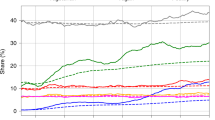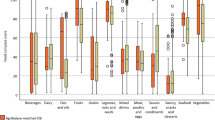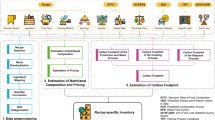Abstract
Contrary to food ingredients, little is known about recipes’ healthiness or environmental impact. Here we examine 600 dinner recipes from Norway, the UK and the USA retrieved from cookbooks and the Internet. Recipe healthiness was assessed by adherence to dietary guidelines and aggregate health indicators based on front-of-pack nutrient labels, while environmental impact was assessed through greenhouse gas emissions and land use. Our results reveal that recipe healthiness strongly depends on the healthiness indicator used, with more than 70% of the recipes being classified as healthy for at least one front-of-pack label, but less than 1% comply with all dietary guidelines. All healthiness indicators correlated positively with each other and negatively with environmental impact. Recipes from the USA, found to use more red meat, have a higher environmental impact than those from Norway and the UK.
This is a preview of subscription content, access via your institution
Access options
Access Nature and 54 other Nature Portfolio journals
Get Nature+, our best-value online-access subscription
$29.99 / 30 days
cancel any time
Subscribe to this journal
Receive 12 digital issues and online access to articles
$119.00 per year
only $9.92 per issue
Buy this article
- Purchase on Springer Link
- Instant access to full article PDF
Prices may be subject to local taxes which are calculated during checkout



Similar content being viewed by others
Data availability
All data besides the UK recipes’ ingredient lists are available in the repository sustainableRecipes54. Source data are provided with this paper.
Code availability
All code can be found in the repository sustainableRecipes54.
References
Afshin, A. et al. Health effects of dietary risks in 195 countries, 1990–2017: a systematic analysis for the Global Burden of Disease Study 2017. Lancet 393, 1958–1972 (2019).
IPCC: Summary for Policymakers. In Special Report on Climate Change and Land (eds Shukla, P. et al.) (Cambridge Univ. Press, 2019).
Crippa, M. et al. Food systems are responsible for a third of global anthropogenic GHG emissions. Nat. Food 2, 198–209 (2021).
Benton, T., Bieg, C., Harwatt, H., Pudassaini, R. & Wellesley, L. Food System Impacts on Biodiversity Loss (Chatham House, 2021); https://www.chathamhouse.org/2021/02/food-system-impacts-biodiversity-loss
Rodríguez Eugenio, N. et al. Hidden Soil Pollution: A Reality (FAO, 2018); https://agris.fao.org/agris-search/search.do?recordID=XF2018001459
Domingo, N. G. et al. Air quality-related health damages of food. Proc. Natl Acad. Sci. USA 118, e2013637118 (2021).
Kopittke, P. M., Menzies, N. W., Wang, P., McKenna, B. A. & Lombi, E. Soil and the intensification of agriculture for global food security. Environ. Int. 132, 105078 (2019).
Sustainable Healthy Diets: Guiding Principles (FAO & WHO, 2019).
Herforth, A. et al. A global review of food-based dietary guidelines. Adv. Nutr. 10, 590–605 (2019).
Springmann, M. et al. The healthiness and sustainability of national and global food based dietary guidelines: modelling study. Br. Med. J. 370, m2322, (2020).
Vitamin and Mineral Requirements in Human Nutrition 2nd edn (WHO, 2004); https://apps.who.int/iris/handle/10665/42716
Food and Environment (Livsmedelsverket, 2021); https://www.livsmedelsverket.se/en/food-habits-health-and-environment/food-and-environment
De Officielle Kostråd - Godt for Sundhed og Klima (Fødevarestyrelsen, 2022); https://altomkost.dk/raad-og-anbefalinger/de-officielle-kostraad-godt-for-sundhed-og-klima/
Seed, B. Sustainability in the Qatar national dietary guidelines, among the first to incorporate sustainability principles. Public Health Nutr. 18, 2303–2310 (2015).
Kovacs, B., Miller, L., Heller, M. C. & Rose, D. The carbon footprint of dietary guidelines around the world: a seven country modeling study. Nutr. J. 20, 15 (2021).
Leme, A. C. B., Hou, S., Fisberg, R. M., Fisberg, M. & Haines, J. Adherence to food-based dietary guidelines: a systemic review of high-income and low- and middle-income countries. Nutrients 13, 1038 (2021).
Buisman, M. E. & Jonkman, J. Dietary trends from 1950 to 2010: a Dutch cookbook analysis. J. Nutr. Sci. 8, e5 (2019).
Bloch Eidner, M., Qvistgaard Lund, A.-S., Harboe, B. S. & Clemmensen, I. H. Calories and portion sizes in recipes throughout 100 years: an overlooked factor in the development of overweight and obesity? Scand. J. Public Health 41, 839–845 (2013).
Trattner, C., Parra, D. & Elsweiler, D. Monitoring obesity prevalence in the United States through bookmarking activities in online food portals. PLoS ONE 12, e0179144 (2017).
van Erp, M. et al. Using natural language processing and artificial intelligence to explore the nutrition and sustainability of recipes and food. Front. Artif. Intell. https://doi.org/10.3389/frai.2020.621577 (2021).
Irwin, H., McCaffrey, T. & Costa, R. Ready, steady, go! Healthy choices in celebrity chef recipe. J. Nutr. Intermed. Metab. 8, 112 (2017).
Howard, S., Adams, J. & White, M. Nutritional content of supermarket ready meals and recipes by television chefs in the United Kingdom: cross sectional study. Br. Med. J. 345, e7607 (2012).
Jones, M. C., Freeth, E. C., Hennesy-Priest, K. & Costa, R. J. A systematic cross-sectional analysis of british based celebrity chefs’ recipes: is there cause for public health concern? Food Public Health 3, 100–110 (2013).
Wademan, J. et al. A recipe for success? A nutrient analysis of recipes promoted by supermarkets. Int. J. Environ. Res. Public Health 17, 4084 (2020).
Schneider, E. P., McGovern, E. E., Lynch, C. L. & Brown, L. S. Do food blogs serve as a source of nutritionally balanced recipes? An analysis of 6 popular food blogs. J. Nutr. Educ. Behav. 45, 696–700 (2013).
Keogh, A. & Chadwick, B. Health food blogger: friend or foe? Br. Dent. J. 227, 1051–1057 (2019).
Dickinson, K., Watson, M. & Prichard, I. Are clean eating blogs a source of healthy recipes? A comparative study of the nutrient composition of foods with and without clean eating claims. Nutrients 10, 1440 (2018).
Trattner, C., Elsweiler, D. & Howard, S. Estimating the healthiness of internet recipes: a cross-sectional study. Front. Public Health 5, 1 (2017).
Cheng, X. et al. Healthfulness assessment of recipes shared on pinterest: natural language processing and content analysis. J. Med. Internet Res. 23, e25757 (2021).
Speck, M. et al. Creating sustainable meals supported by the NAHGAST online tool—approach and effects on GHG emissions and use of natural resources. Sustainability 12, 1136 (2020).
Reynolds, C. et al. Comparing the environmental impacts of recipes from four different recipe databases using natural language processing. In LEAP Conference (the authors, 2021); https://openaccess.city.ac.uk/id/eprint/27235/
Looking at Labels (British Nutrition Foundation, 2019); http://web.archive.org/web/20211019221848/https://www.nutrition.org.uk/putting-it-into-practice/food-labelling/looking-at-labels/
Ahmed, M. et al. Evaluating the consistency of the French Nutri-Score front-of-pack scoring system with Canadian dietary guidelines. Curr. Dev. Nutr. 4, 1711 (2020).
Chantal, J. et al. Discriminating nutritional quality of foods using the 5-color nutrition label in the French food market: consistency with nutritional recommendations. Nutr. J. 14, 100 (2015).
Szabo de Edelenyi, F. et al. Ability of the Nutri-Score front-of-pack nutrition label to discriminate the nutritional quality of foods in the German food market and consistency with nutritional recommendations. Arch. Public Health 77, 28 (2019).
Dréano-Trécant, L. et al. Performance of the front-of-pack nutrition label Nutri-Score to discriminate the nutritional quality of foods products: a comparative study across 8 European countries. Nutrients 12, 1303 (2020).
van Tongeren, C. & Jansen, L. Adjustments needed for the use of Nutri-Score in the Netherlands: lack of selectivity and conformity with Dutch dietary guidelines in four product groups. Int. J. Nutr. Food Sci. 9, 33 (2020).
Kostrådene (Helsedirektoratet, 2016); https://www.helsedirektoratet.no/faglige-rad/kostradene-og-naeringsstoffer/kostrad-for-befolkningen#fisk-til-middag-to-til-tre-ganger-i-uken
Dietary Guidelines for Americans 2020–2025 9th edn (US Department of Agriculture & US Department of Health and Human Services, 2020); https://www.dietaryguidelines.gov/resources/2020-2025-dietary-guidelines-online-materials
The Eatwell Guide (NHS, 2019); https://www.nhs.uk/live-well/eat-well/the-eatwell-guide/
Anbefalinger om Kosthold, Ernaering og Fysisk Aktivitet (Helsedirektoratet, 2014).
Mertens, E. et al. Dietary choices and environmental impact in four European countries. J. Clean. Prod. 237, 117827 (2019).
Trattner, C. & Elsweiler, D. Investigating the healthiness of internet-sourced recipes implications for meal planning and recommender systems. In 26th International World Wide Web Conference, WWW 2017, 489–498 (International World Wide Web Conferences Steering Committee, 2017); https://doi.org/10.1145/3038912.3052573
Norwegian Food Composition Database (Norwegian Food Safety Authority, 2020); https://www.matvaretabellen.no
FoodData Central (US Department of Agriculture Agricultural Research Service, 2019).
Mertens, E. et al. SHARP-Indicators Database towards a public database for environmental sustainability. Data Br. 27, 104617 (2019); https://doi.org/10.1016/j.dib.2019.104617
Østerholt Dalane, J. Weights, Measures and Portion Sizes for Foods [Mål, Vekt og Porsjonsstørrelser for Matvarer] (Norwegian Food Safety Authority, University of Oslo, Norwegian Directorate of Health, 2015); http://www.med.uio.no/imb/om/aktuelt/aktuelle-saker/2015/dokumenter/mal-vekt-og-porsjonsstorrelser-for-matvarer-2015.pdf
Diet, Nutrition and the Prevention of Chronic Diseases Technical Report Series Vol. 916 (WHO, 2003)
Nordic Nutrition Recommendations 2012 5th edn (Nordic Council of Ministers, 2014).
Nutri-Score (Santé Publique France, 2020); https://www.santepubliquefrance.fr/en/nutri-score
Starke, A. D., Willemsen, M. C. & Trattner, C. Nudging healthy choices in food search through visual attractiveness. Front. Artif. Intell. 4, 621743 (2021).
Kassambara, A. rstatix: Pipe-Friendly Framework for Basic Statistical Tests. R package version 0.7.0. https://cran.r-project.org/package=rstatix (2021).
Raiche, G. psych: Procedures for Psychological, Psychometric, and Personality Research. R package version 2.1.6. https://cran.r-project.org/package=psych (2013).
Angelsen, A. AslaugL/sustainableRecipes: v.1.0.0. Zenodo https://zenodo.org/record/7792940 (2023).
Acknowledgements
This work was in part supported by the Research Council of Norway with funding to MediaFutures: Research Centre for Responsible Media Technology and Innovation, through the Centre for Research-based Innovation scheme, project number 309339.
Author information
Authors and Affiliations
Contributions
A.A. and C.T. conceptualized and designed the study. A.A. and C.T. were involved in data collection for the study. A.A. conducted the analyses. All authors were involved in the interpretation of the results of the analysis. A.A. drafted the manuscript, and C.T. and A.D.S. revised the article. All authors reviewed the final manuscript and approved it for submission.
Corresponding authors
Ethics declarations
Competing interests
The authors declare no competing interests.
Peer review
Peer review information
Nature Food thanks Chloe Astbury, Tom Ball and the other, anonymous, reviewer(s) for their contribution to the peer review of this work.
Additional information
Publisher’s note Springer Nature remains neutral with regard to jurisdictional claims in published maps and institutional affiliations.
Extended data
Extended Data Fig. 1
The percentage of recipes that adhered to each of the criteria that made up the World Health Organization (top) and Nordic Nutrition Recommendations (bottom) dietary guidelines, by country.
Extended Data Fig. 2 The recipes’ raw scores on disqualifying (1–10) and qualifying (1–5) components of the Nutriscore, by country.
The lower and upper edges of the box show the 25th and 75th quartile respectively, with whiskers extending to the value no further than 1.5 times away from the quartile value. The thick line inside the box is the median. The sample size for each country is Norway: 388, UK: 100 and USA: 98.
Extended Data Fig. 3 The (inverted) individual scores from each component of the multiple traffic light system, by country.
The lower and upper edges of the box show the 25th and 75th quartile respectively, with whiskers extending to the value no further than 1.5 times away from the quartile value. The thick line inside the box is the median. The sample size for each country is Norway: 388, UK: 100 and USA: 98.
Supplementary information
Supplementary Information
Supplementary Tables 8–11.
Supplementary Tables
Supplementary Table 1: The IDs from the Norwegian Food Composition Database and FoodData Central that ingredients were mapped to. Supplementary Table 2: The IDs from the Sharp Indicators Database that ingredients were mapped to. Supplementary Table 3: The raw nutrient and environmental impact values for each recipe. Supplementary Table 4: The raw nutrient values used to calculate the healthiness scores for each recipe. Supplementary Table 5: The percentage of the RDI of each nutrient in the individual recipes per 100 g. Supplementary Table 6: The individual healthiness indicator scores for each recipe. Supplementary Table 7: The URLs of the recipes collected online. Title has been added to each table using the ‘Title’ option in Numbers, while the descriptive caption has been added in the ‘Infotext’ box.
Source data
Source Data Figs. 1–3, Extended Data Figs. 1–3, and Extended Data Tables 1 and 2.
Fig. 1. Protein source of the recipes, their content of meat and meat-based products, and environmental impact of recipes by protein source. Fig. 2. Healthiness indicator score and environmental impact of the recipes. Fig. 3. Healthiness indicator score, environmental impact and individual nutrient content of recipes. Extended Data Fig. 1. Percentage of recipes that adhered to each dietary guideline criteria. Extended Data Fig. 2. Recipes raw scores on Nutri-Score components. Extended Data Fig. 3. Recipes’ raw scores on FSA-MTL criteria. Extended Data Table 1. The percentage of recipes that received a specific score on each FOPL indicator. Extended Data Table 2. The percentage of recipes that received a specific score on the dietary guideline indicators.
Rights and permissions
Springer Nature or its licensor (e.g. a society or other partner) holds exclusive rights to this article under a publishing agreement with the author(s) or other rightsholder(s); author self-archiving of the accepted manuscript version of this article is solely governed by the terms of such publishing agreement and applicable law.
About this article
Cite this article
Angelsen, A., Starke, A.D. & Trattner, C. Healthiness and environmental impact of dinner recipes vary widely across developed countries. Nat Food 4, 407–415 (2023). https://doi.org/10.1038/s43016-023-00746-5
Received:
Accepted:
Published:
Issue Date:
DOI: https://doi.org/10.1038/s43016-023-00746-5
This article is cited by
-
Ethical Perspectives on Food Morality: Challenges, Dilemmas and Constructs
Food Ethics (2024)
-
Health and sustainability of everyday food
Nature Food (2023)



